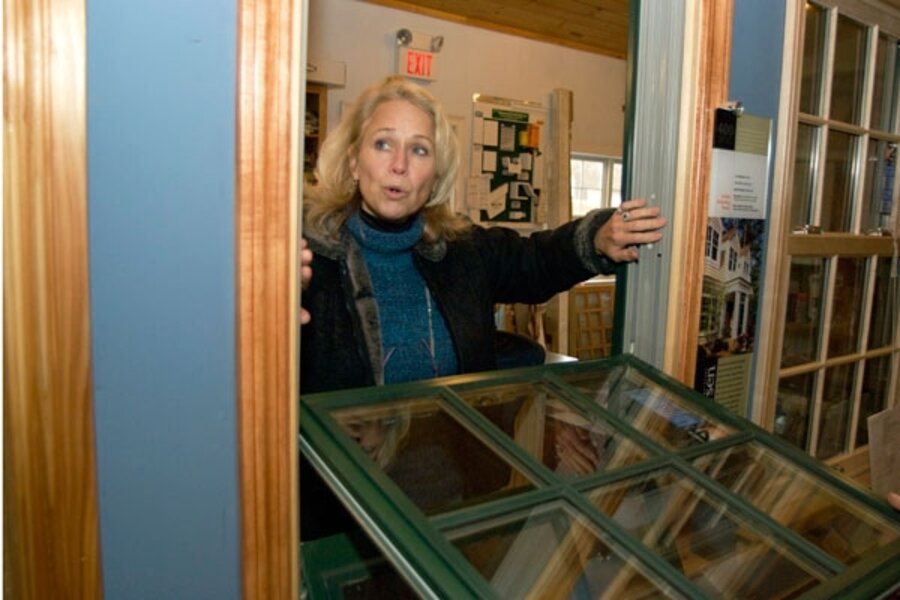How to choose energy-efficient windows
Loading...
The decision to install energy efficient windows for our green renovation of Sheepdog Hollow was a no-brainer: The better a house is insulated, the more efficiently its heating and cooling systems will work.
And since we love natural light and want to take advantage of the bucolic views of the rolling fields, graceful old elms, and a pond on the property, we knew we were going to put in a lot of windows.
The key question was: how to choose the best window, with the best thermal efficiency, for the job.
On the Web, I found quite a few resources. The Efficient Windows Collaborative has a tool to help you determine how much money in heating and cooling costs can be saved annually by installing various types of energy-efficient windows.
In our area, it was more than a thousand dollars a year, based on a 2,000 square- foot house with 300 square feet of window area (15 percent of floor area).
That was impressive enough. But when I began to examine the different types of windows available, the choices left me befuddled. I had no idea what the difference was between a triple-glazed window with Low-Solar-Gain Low-E, Argon/Krypton Gas and a double-glazed one with Bronze/Gray Tint.
The Efficient Windows Collaborative offers detailed explanations about each one, but I wanted an explanation that was easier for layperson to understand. So I turned to Bob Siekierski, the windows expert at Shagbark True Value, our local hardware store.
He was very much to the point: “Windows aren’t as complicated as geothermal [heating, which we'd already researched and chosen]. They're basically just glass and sticks.”
Well, sort of. With energy-efficient windows, one has to understand things like U-Factors and Low-E coatings on the glass.
Low-E coating are simply “high-tech, reflective coatings,” Bob says. “They reflect heat in, and reflect UV light out. In other words, it lets the sunlight in but not the damaging rays – the ones that fade your curtains and rugs.”
“Do they wear off?” I asked.
“No, they don’t wear off,” he says. “There’s a 20-year warranty on the glass.”
He explained that there different types of coatings, from a simple Low E glass pane to more sophisticated ones like Andersen’s SmartSun glass.
The coatings on many types of low-E glass can give a slight tint to the glass, which helps keep the harmful rays out while they reflect heat in.
The ideal is a window that lets in as much visible light as possible as it blocks out the ultraviolet rays and keeps as much heat in. That’s the U-factor, which Bob explains as “the energy retention – how much heat it lets in and out. Low U-factor numbers are good.”
Low U-factors are not only “good,” they’re also required for the federal tax break of up to $1,500 for installing energy-efficient windows. To qualify, you have to install windows with a U-factor of .30 or less. (The tax credit is good until December 31, 2010.)
After looking at the various options, we chose to go with the Andersen SmartSun because it appears to let in the most sun and still has a U-factor low enough to qualify for the tax credit.
But the biggest bonus from these windows, as I mentioned in my previous post, is that they also are “self-cleaning” on the outside, according to Bob. When he first mentioned this, I didn’t quite believe it.
“You mean I won’t have to clean the outside of my windows?” I asked.
“According to Andersen, no,” says Bob. “No water spots, ever. There’s a coating they put on it that’s activated by sunlight that makes it so the window can’t water spot.”
Now that's a reason to buy a window. (No, not the only reason, of course -- green comes first -- but a good reason to choose one type over another.)
Next: Why we chose a closed-loop geothermal system
Editor's note: Alexandra Marks will be blogging twice a week about her green and budget-friendly restoration of a 1902 farmhouse in Connecticut. See a photo gallery of the early days of the project by clicking here. You can read all she's written about the project so far by clicking here and then looking for Sheep Dog Hollow under Topics on the right side of the page.
You'll find numerous articles about the environment at the Monitor’s main environment page. Also, check out our Bright Green blog archive and our RSS feed.





